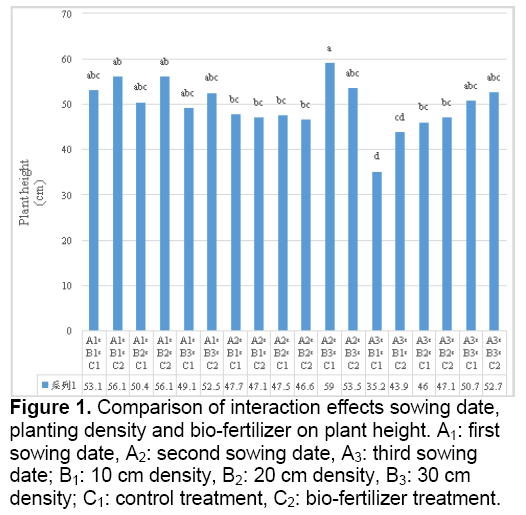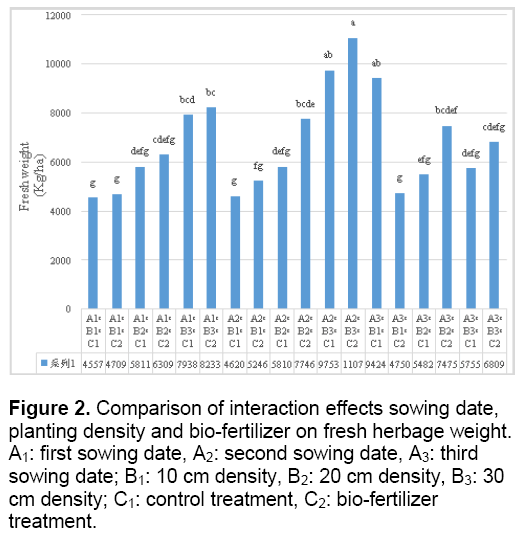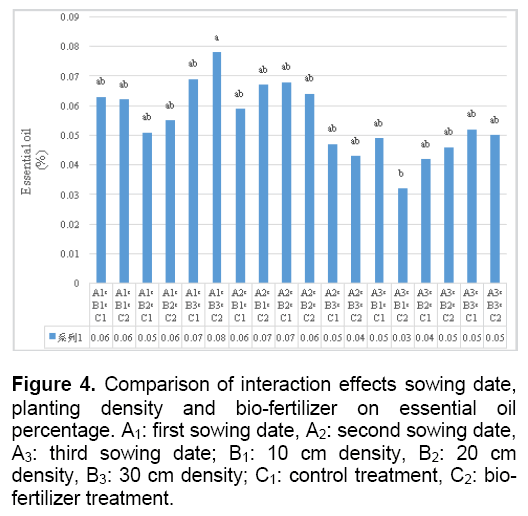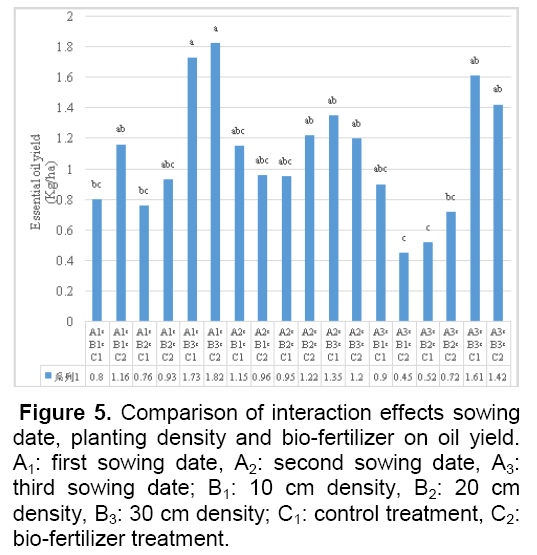The Effect of Swoing Date, Planting Density and Bio-fertilizers on the Essential Oil Content of Dragonhead (Dracocephalum moldavica L.) in Sari Climatic Condition
Seyyed Hossein Hashemian Ahmadi, Amin Hadipanah
Seyyed Hossein Hashemian Ahmadi*,Amin Hadipanah
Department of Horticultural,Science and Research Branch,Islamic Azad University,Tehran,Iran.
- Corresponding Author:
- Seyyed Hossein Hashemian Ahmadi
Department of Horticultural
Science and Research Branch
Islamic Azad University,Tehran,Iran
E-mail: hossein.hashemian83@yahoo.com
Abstract
Dragonhead (Dracocephalum moldavica L.) is an annual, herbaceous plant belongs the family Lamiaceae. Dragonhead has some therapeutic properties such assedative, tonic, antimicrobial. In order to study the effects of sowing date, density and bio-fertilizers on essential oil content and some morphological characteristics of dragonhead, a field experiment was conducted in Sari Agricultural Sciences and Natural Resources university by using of split-plot design in the base of randomized complete blocks with three replications in 2011. Which has been in three sowing dates (12 of June, 5 of July and 17 of July) as main factors, three planting density levels (30 × 10, 30 × 20 and 30 × 30 cm) and bio-fertilizer levels on two surfaces including (Humiforte biofertilizer and non biofertilizer). The results of the analysis of variance indicated that sowing date had significant effect on plant height, oil percentage and oil yield but planting density had significant effect only on the fresh herbage and dry herbage also bio-fertilizer had no significant effect on the parameters of research. Results of mean comparisons revealed that the highest fresh herbage weight (7374.7 kg) and the highest oil yield (1.197 kg) were obtained at the second sowing date (July 5). The highest dry herbage weight (2007 kg) was obtained at the third sowing date (July 17) and the highest oil content (0.065 %) was obtained at the first sowing date (June 12). Results of mean comparisons revealed that the highest fresh herbage weight (8260.2 kg), the highest dry herbage weight (2787.5 kg) and the highest oil yield (1.53 kg) were obtained at the planting density (10 cm) but the highest oil content (0.058 %) was obtained at the planting density (30 cm). In general according to survey results can determine June 12 as sowing dates and 30 cm as the density and lack of bio-fertilizers for dragonhead herb according to weather conditions of Sari city of Mazandaran province
Keywords
(Dracocephalum moldavica L.); Sowing date; planting density; bio-fertilizer; essential oil.
1. Introduction
Dragonhead with scientific name (Dracocephalum moldavica L.) is an annual herbaceous,sometimes biennial,which is aromatic,with a chromosome number of 2n = 2x = 10,and belonging to the mint (Lamiaceae) family. There is 45 species of herbaceous and shrub's dragonhead in the world and there is 8 species of annual and perennial herbaceous and fragrant in Iran which three of them are endemic to Iran [1,2]. The origin of this plant is reported from southern Siberia and the Himalaya and naturally grows in temperate Zones of Europe & Asia [3,4,5].
In the study of Abd-El-Baky and El-Baroty [6] on the dragonhead they found that 44 combination of essential oils was obtained which consist 97.18 % of essential oil and 90 % of them was combined with oxygenated monoterpenes and consisted less than one percent of the weight of the plant which include compounds such as: gerannyl acetate,neryl acetate,geranial,geraniol,neral,nerol,linalool. Dragonhead has some therapeutic properties such assedative,tonic,antimicrobial,and wound healer [7].
Environmental factors have an important effect on the product yield and its components derived from herbs. However,it was not possible to fully control these factors but can managed environmental impact with a certain methods,which plant under those conditions appear its potential,among them,factors such as sowing date and density play an essential role in achieving the proper conditions during the period of growth to achieve maximum performance in medicinal plants [8].
In addition to sowing time and planting density is also an important factor in determining productivity. So that,if the rate of planting density is greater than optimal level,environmental factors will not be enough for the plant,conversely,if the planting density is less than optimal level so available environmental facilities are not used effectively,and leading to a decrease in the product [9].
Davazdahmami et al [10] in a study on the essential oil of dragonhead conducted cultivation in autumn,spring and summer in Isfahan,and three treatments of winter crop,sown in spring and summer were compared together,and they found that the growth of dragonhead in spring sowing is more than summer sowing,and autumn sowing was not successful at all. A report by Bourna et al [11] performed an experiment as different sowing time effects on growth,yield and essential oil content from (Dracocephalum moldavica L.). The results showed that the highest plant (82.5 Cm) and the largest number of branches per plant (18.14) was obtained from the plants which were sown on 19 of March and essential oil content (199.0 Kg) was obtained from the plants which were sown on 4 of April. Haj Seyyedhadi et al [12] according to a survey reported that with sowing chamomile in sowing pattern (20 × 50 cm) the maximum essential oil yield and performance of kamazolen is achieved. Mohammadpour et al. [13] reported that on (Satureja hortensis L.) the highest plant height (52.3 cm),lateral shoot (23.22 N/P),number of nod (17.81),shoot diameter (8.8 mm),root diameter (9.12 mm) and dry weight of root (2.76 g/p) were recorded for first sowing date (11 April). The highest dry shoot yield (3023.1 and 2663.9 kg/ha) was obtained at third and second sowing time (22 April and 3 May). The highest plant height (53.03 and 51.09 cm),lateral stem (21.94 and 21.79 N/P),number of nod (17.06 and 16.32) and shoot diameter (7.92 and 7.4 mm) were obtained at third and second densities (25×35 and 35×35cm) in Sari condition. Ahmed and Haque [14] studied the effect of row spacing (15,20,25 and 30 cm) and time of sowing (November 1,November 20,December 10 and December 30) on the yield of black cumin (Nigella sativa) in Bangladesh,they found that closer row spacing (15 cm) and early sowing (November 1) was the best for higher seed yield of black cumin. Omidbeigi et al. [15] with evaluating of the effect of vermicompost,bio phosphate and azote bacteria on dragonhead showed that the highest essential oil in vegetative body (0.74 %) and the maximum amount of geranyl acetate (61.1 %) was achieved from treatment of 30 % vermicompost pot size.
The aim of this study was to evaluate effects of sowing date,planting density and bio-fertilizer on essential oil percentage and some morphological characteristics of dragonhead (Dracocephalum moldavica L.) in the weather condition of Sari.
2. Materials and Methods
Plant materials,chemicals and instruments
In order to study the effects of sowing date and density on essential oil content and some morphological characteristics of dragonhead,a field experiment was conducted in Sari Agricultural Sciences and Natural Resources university by using of split-plot design in the base of randomized complete blocks with three replications in 2011.
Which has been in three sowing dates (12 of June,5 of July and 17 of July) as main factors,three planting density levels (30 × 10,30 × 20 and 30 × 30 cm) and bio-fertilizer levels on two surfaces including (Humiforte biofertilizer and non biofertilizer).
Location of test implementation has the (latitude. 36°,39´ N,longitude. 53°,4´ E,altitude 16 m above sea level). After land preparation which was including plowing,disking and rotivator than classification of farm plots based on the scheme is investigating. The experimental plots size was 1.25 × 2.75 meter. The dragonhead seeds was prepared from Karaj city. For fast germination of dragonhead seeds,was used from stalk and stover mulch that have very much effect on dragonhead seeds germination and protect of planting bed humidity. Texture of soil's location has been loam and fight against weeds was performed mechanically (twist hand weeding). In order to investigate the physical and chemical properties of field soil,one sample of that was transferred to the laboratory and was analyzed. The soil of the field with pH 8.1,contains total N (0.05%),total P2O5 (9 ppm) and total K2O (234 ppm) with an EC of 0.63 (ds/m). In every experimental units,attributes such as: Plant height (cm),yield of fresh and dry weight of plants per hectare,percentage and yield of essential oil per hectare was measured. Harvest in full bloom was performed at the middle of line plots.
Extraction of essential oil
In the this method,the essential oil was extracted from the amount of 80 g of inflorescences,stems and dried leaves of dragonhead in 2 treatments (sowing date and plant density) in 1 L of water contained in a 2 L flask and heated by heating jacket at 100 °C for 4 h in a Clevenger–type apparatus,according to producers outlined British Pharmacopoeia.
Statistical analysis
All data obtained based on two split-plot design in randomized complete block design was analyzed,Means of the traits were compared by Duncan’s multiple range test at p < 0.05 level. Analytical data for hierarchical cluster analysis were treated by means of the SPSS statistical software.
3. Results
3.1. Plant height
The results of the analysis of variance (Table 1) indicated that sowing date factor had a significant effect on plant height and also bio-fertilizer and plant density had no significant effect on plant height. Interaction between sowing dates and bio-fertilizer,bio-fertilizer and plant density and interaction effects of sowing date,plant density and bio-fertilizer had no significant effect on plant height. Results of mean comparisons,plant height revealed that the highest plant height (52.88 cm) was obtained at the sowing date (June 12) and the highest plant height (52.90 cm) was obtained at the planting density (10 cm) (Table 2). According to Table 3,interaction effects sowing date and planting density on plant height revealed that the highest plant height (56.26 cm) was obtained at the second sowing date (July 5) and planting density (30 cm).
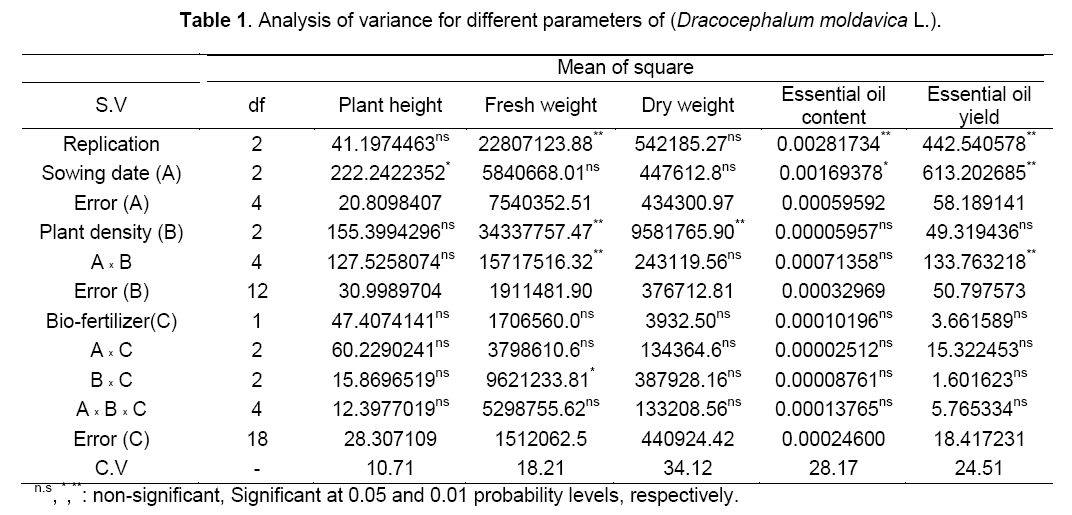
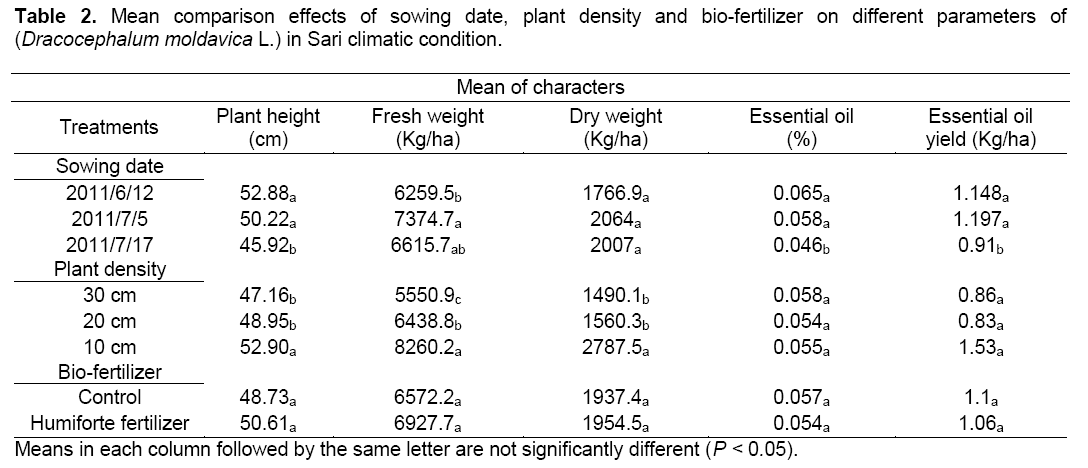
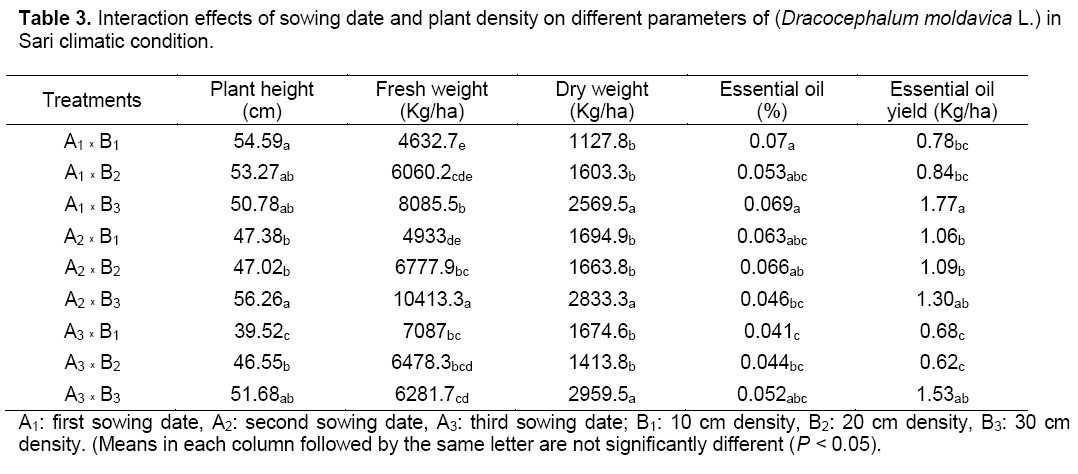
According to Table 4,interaction effects sowing date and bio-fertilizer on plant height revealed that the highest plant height (54.89 cm) was obtained at the first sowing date (June 12) and Humiforte fertilizer.
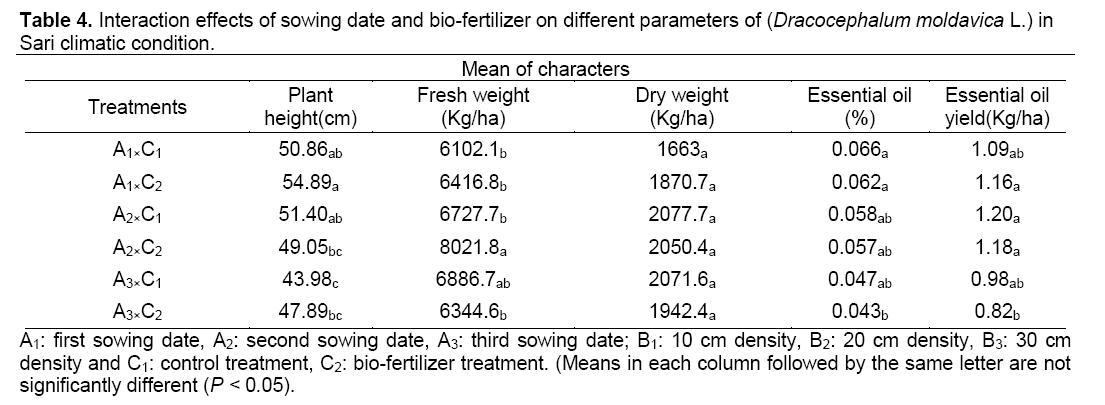
The results of the interaction effects planting density and bio-fertilizer on plant height revealed that the highest plant height (52.93 cm) was obtained at the planting density (30 cm) and non biofertilizer (Table 5). According to Figure 1,comparison of interaction effects sowing date,planting density and bio-fertilizer on plant height revealed that the highest plant height (59.03 cm) was obtained at the second sowing date (July 5),planting density (30 cm) and non biofertilizer.
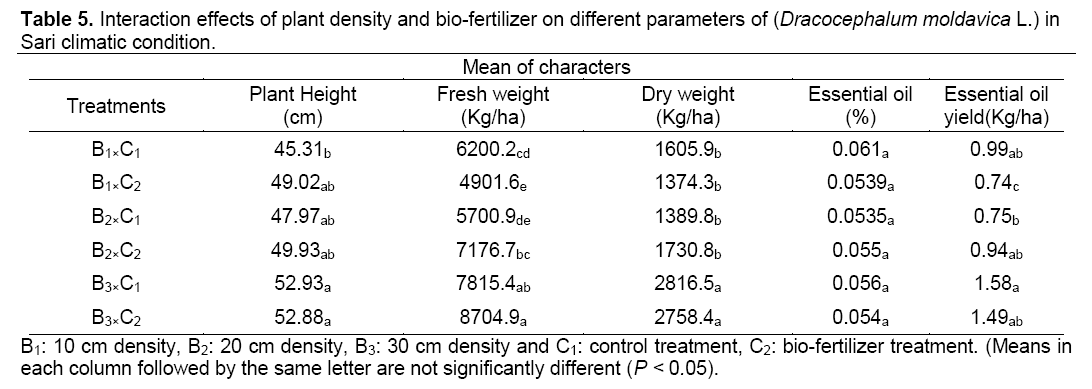
3.2. Fresh and dry herbage
The results of the analysis of variance (Table 1) indicated that sowing date factor had no significant effect on the fresh and dry weight of plant,but the plant density had a significant effect on that. Factor of bio-fertilizer had no significant effect on the yield of fresh and dry weight. Also the interaction of sowing date and bio-fertilizer,and the interaction of sowing date,plant density and bio-fertilizer had no significant effect on the fresh and dry weight of plant. However,the interaction effect of plant density and bio- fertilizer had a significant effect on the level of 5% of the fresh weight of plant.
Results of mean comparisons,fresh herbage revealed that the highest fresh herbage weight (7374.7 kg/ha) was obtained at the second sowing date (July 5) and the highest fresh herbage weight (8260.2 kg/ha) was obtained at the plant density (10 cm) (Table 2). According to Table 3,interaction effects sowing date and planting density on fresh herbage revealed that the highest fresh herbage weight (10413.3 kg/ha) was obtained at the second sowing date (July 5) and planting density (30 cm).
According to Table 4,interaction effects sowing date and bio-fertilizer on fresh herbage weight revealed that the highest fresh herbage (8021.8 kg/ha) was obtained at the second sowing date (July 5) and Humiforte fertilizer. The results of the interaction effects planting density and bio-fertilizer on fresh herbage revealed that the highest fresh herbage (8704.9 kg/ha) was obtained at the planting density (30 cm) and Humiforte fertilizer (Table 5). According to Figure 2 ,comparison of interaction effects sowing date,planting density and bio-fertilizer on fresh herbage weight revealed that the highest fresh herbage (11073 kg/ha) was obtained at the second sowing date (July 5),planting density (30 cm) and Humiforte fertilizer.
Results of mean comparisons,dry herbage revealed that the highest dry herbage weight (2007 kg/ha) was obtained at the third sowing date (July 17) and the highest dry herbage weight (2787.5 kg/ha) was obtained at the planting density (10 cm) (Table 2).
According to Table 3,interaction effects sowing date and plant density on dry herbage revealed that the highest dry herbage weight (2959.5 kg/ha) was obtained at the third sowing date (July 17) and planting density (30 cm).
According to Table 4,interaction effects sowing date and bio-fertilizer on dry herbage weight revealed that the highest dry herbage (2077.7 kg/ha) was obtained at the second sowing date (July 5) and non biofertilizer. The results of the interaction effects planting density and bio-fertilizer on dry herbage revealed that the highest dry herbage (2816.5 kg/ha) was obtained at the planting density (30 cm) and non biofertilizer. (Table 5). According to Figure 3 ,comparison of interaction effects sowing date,planting density and bio-fertilizer on dry herbage weight revealed that the highest fresh herbage (3071.4 kg/ha) was obtained at the third sowing date (July 17),planting density (30 cm) and non biofertilizer.
3.3. Content and oil yield
The results of the analysis of variance (Table 1) indicated that sowing date factor had a significant effect on essential oil percentage and yield,but bio-fertilizer and plant density had no significant effect on essential oil percentage and yield. The interaction sowing date and bio-fertilizer,bio-fertilizer and plant density and sowing date interaction,bio-fertilizer and plant density had no significant effect on essential oil percentage and yield.
Results of mean comparisons,oil content revealed that the highest oil content (0.065 %) was obtained at the first sowing date (June 12) and the highest oil content (0.058 %) was obtained at the planting density (30 cm) (Table 2).
According to Table 3,interaction effects sowing date and planting density on oil content revealed that the highest oil content (0.07 %) was obtained at the first sowing date (June 12) and planting density (10 cm). According to Table 4,interaction effects sowing date and bio-fertilizer on oil content revealed that the highest oil content (0.066 %) was obtained at the first sowing date (June 12) and non biofertilizer. The results of the interaction effects planting density and bio-fertilizer on oil content revealed that the highest oil content (0.061 %) was obtained at the planting density (10 cm) and non biofertilizer (Table 5). According to Figure 4 ,comparison of interaction effects sowing date,planting density and bio-fertilizer on oil content revealed that the highest oil content (0.078 %) was obtained at the first sowing date (June 12),planting density (30 cm) and Humiforte fertilizer.
Figure 4: Comparison of interaction effects sowing date, planting density and bio-fertilizer on essential oil percentage. A1: first sowing date, A2: second sowing date, A3: third sowing date; B1: 10 cm density, B2: 20 cm density, B3: 30 cm density; C1: control treatment, C2: bio-fertilizer treatment.
Results of mean comparisons,oil yield revealed that the highest oil yield (1.197 kg/ha) was obtained at the second sowing date (July 5) and the highest oil yield (1.53 kg/ha) was obtained at the planting density (10 cm) (Table 2). According to Table 3,interaction effects sowing date and planting density on oil yield revealed that the highest oil yield (1.77 kg/ha) was obtained at the first sowing date (June 12) and planting density (30 cm). According to Table 4,interaction effects sowing date and bio-fertilizer on oil yield revealed that the highest oil yield (1.20 kg/ha) was obtained at the second sowing date (July 5) and non biofertilizer. The results of the interaction effects planting density and bio-fertilizer on oil yield revealed that the highest oil yield (1.58 kg/ha) was obtained at the planting density (30 cm) and non biofertilizer (Table 5). According to Figure 5 ,comparison of interaction effects sowing date,planting density and bio-fertilizer on oil yield revealed that the highest oil yield (1.82 kg/ha) was obtained at the first sowing date (June 12),planting density (30 cm) and Humiforte fertilizer.
4. Discussions and Conclusion
Growth and production of medicinal plants like other plants is influenced by genetic and agronomic factors. Choosing the most suitable sowing date and plant density is one of the most important factors of success in agriculture.
It appears that the increase in plant height following the increase in plant density was brought about by the increase in the inter-plant competition over light and the disruption of the balance of growth regulators. In order words,the decrease in light penetration into middle and lower layers of canopy decreases auxin decomposition and thus,plant height increases and under these conditions,plant height increases if other environmental parameters such as moisture and soil fertility,do not limit the growth of plants [16].
For each product there is an optimum sowing date which its delay can usually reduce the yield. Agriculture experts believed that the establishment of an appropriate density of healthy plants at the farm levels,is the foundation of a successful system of agronomic. At densities less than optimum use of available environmental factors such as light,moisture and nutrients was not maximum,and also at densities higher than optimal the existence of intense competition would reduce the yield of the final product [17]. About the effect of sowing date on the dragonhead medicinal plant,various researchers have been tested on the best time to sowing which considering the climatic conditions of test location,different results have been achieved,so that Halaszzelnik et al. [18] suggested late march or early April as the best time for sowing,and Suchorska et al. [19] have introduced may month as the best time for that.
Results of mean comparisons revealed that the highest fresh herbage weight (7374.7 kg) and the highest oil yield (1.197 kg) were obtained at the second sowing date (July 5). The highest dry herbage weight (2007 kg) was obtained at the third sowing date (July 17) and the highest oil content (0.065 %) was obtained at the first sowing date (June 12). Results of mean comparisons revealed that the highest fresh herbage weight (8260.2 kg),the highest dry herbage weight (2787.5 kg) and the highest oil yield (1.53 kg) were obtained at the planting density (10 cm) but the highest oil content (0.058 %) was obtained at the planting density (30 cm) (Table 2,3). Harvesting of dragonhead in summer sowing (during 61 days) more than spring sowing (during 22 days) allows sowing after grain autumn harvest and provides adequate opportunity to prepare the land for the next autumn sowing [10]. Arabaci and Bayram [20] with sowing basil at 3 different densities (20,40 and 60 plants per square meter) in two cases of fertilization with nitrogen and without fertilization,reported that the highest fresh and dry yield,percentage and yield of active ingredients were achieved in the density of 20 plants per square meter with the mode of fertilization. Also the highest yield of fresh weight plant (8260.2 kg) and dry weight plant (2787.5 kg/ha) was obtained from a density of 10 cm (Table 2).
From the above results it comes on to gain much dry weight of the plant,should create less density. Growth and production of medicinal plants like other plants is influenced by genetic and agronomic factors. Choosing the most suitable sowing date and plant density is one of the most important factors of success in agriculture. Because seed set depends on sufficient nutrients they provide and environmental conditions while shift from vegetative to reproductive stage,increased planting densities result in limited availability of nutrients,light and water so the number of reproductive units decrease; at last seed number reproduction decreases. Shalaby and Razin [21] were cultured thyme in rows of 60 cm and plant distance (15,30 and 45 cm). Results showed that the distance of 45 cm support plant growth and that yield. But the maximum essential oil yield was obtained at a distance of 15 cm. Close distance causes a significant progress in yield and essential oil content. But the percentage of essential oil of the dried plant was not affected by distance.
Daadkhaah et al. [22] with evaluate the effect of sowing dates and plant density on growth and yield and quality of chamomile have concluded that crop season significantly affected on the growth characteristics and yield of chamomile,so that in the autumn sowing the plant height,number of main stem and sub,flowering period,number of flowers per plant and flowers yield per unit area was higher than spring sowing. The highest yield of flowers were achieved from a rows of 20 cm at a density of 100,000 plants per hectare. At higher densities due to the large number of plants per unit area wet and dry performance increasing. Morteza et al. [23] with evaluating of sowing date and plant density on essential oils and combinations of valerian reported that the highest essential oils and its major combinations were achieved from sowing date of 30 August and a density of 40,000 plants per hectare. According to study of Davazdahemami et al. [10] dragonhead height reduced from 93 cm to 58 cm in summer sowing. Also study of Burna et al. [11] on the dragonhead showed that spring sowing in terms of higher essential oil combinations has the advantage than summer sowing. In the spring and summer sowing amount of granyal acetate was measured respectively: 35.3 and 14.1%,and geranyal 15% and 19.7 %,and geraniol 20.1 and 15%. Resaam et al. [24] to investigate the effect of sowing date and sowing density on yield and grain yield components of anise showed that the sowing dates,density levels and their interaction had a significant effect on the most studied traits. Totally the highest grain yield of anise was obtained in the first sowing date (10 March) with a density of 40 plants square meter. Azizi [25] in a similar survey mentioned late February as the best time to anise sowing and noted that postponing of cultivation after this date will result in the loss of 40-30 percent of yield. Akbarinia et al. [26] have been reported that fennel plant's yield in autumn sowing is more than spring sowing and stated that cultivation in autumn has higher grain yield for this reasons; better establishment,cold tolerance,early onset,spring growth,and consequently higher foliage and seed weight.
Ebadi et al. [27] reported that on (Matricaria recutita L.) the highest essential oil content (0.72 percent w/w),essential oil yield (0.26 g/m2) and α-bisabolol yield (0.2375 g/m2) were obtained from the second harvest of March and the most chamazulene yield (0.0473 g/m2) was obtained from the third harvest of March sowing date in Mashhad condition. Qualitative and quantitative changes in the essential oil of thyme in Iran,over a period of growth and various density was examined and showed that plant density and harvest time has a significant effect on the quality and quantity of thyme performance. So that the maximum dry yield of plant,the performance of essential oils and thymol yield was observed at the beginning of flowering and a density of 15 cm [28].
Applying of biofertilizers such as nitrogen fixing bacteria has led to a decrease in the use of chemical fertilizers and has provided high quality products free of harmful agrochemicals for human safety [29]. Bio-fertilizers are capable of mobilizing nutritive elements from no usable form to usable form through biological processes. P-solubilizers are bio-fertilizers that solubilize the phosphorus in soil and make it available to plants. They can improve growth,yield as well as the productivity of the crop [30]. Omidbeigi et al. [15] with evaluating of the effect of vermicompost,bio phosphate and azote bacteria on dragonhead showed that maximum amount of geraniol (24.2 %) was achieved in 15 % of the treatment and non-application of bio-phosphate,and maximum amount of geranyal (18.2 %) was obtained from the the treatment of 15 % vermicompost and lack of azotobacteria.
Evaluate the quantity outcomes of the essential oil showed that to achieve the highest level of essential oils,its better to use this plant in summer cultivation,weather conditions of Sari city of Mazandaran province in north of Iran,at the first sowing date,and a planting density of 30 cm and lack of bio- fertilizers for dragonhead herb. For achieve to better quantity and quality of the essential oil of dragonhead,the sowing of Deracocephalum moldavica L. plant in early times will be better than these dates that used in this investigation.
References
- Mirheydar H. (1994). Maaref giahi. Daftare nashre farhange islami,Tehran,1:109-111.
- Mozaffarian V. (1996). A Dictionary of Iranian Plant Names. Farhang Moaser,Tehran,Iran. pp. 542.
- Omidbaigi R. (2005). Production and processing of medicinal plants. Astan Quds Razavi publications. Behnashr. Mashhad,Vol. 2: 438.
- Galambosi B.,Holm Y.,Hiltunen R. (1989). The effect of some agrotechnical factors on the herb yield and volatile oil of dragonhead. Journal of essential oil research,1: 287-292.
- Galambosi B.,Holm Y. (1989). The effect of nitrogen fertilization on the herb yield of dragonhead. Journal of Agricultural Science in Fanland,61: 387-394.
- AbdEl-Baky H.H.,El-Baroty G.S. (2007). Chemical and biological evaluation of the essential oil of Dracocephalum moldavian L. Chemical and biological evaluation of the essential oil,international journal of integrative biology,2(2): 74-80.
- El-Gengaihi S.,Wahba H. (1995). The response of Dracocephalum moldavica L. plant to nitrogen fertilization and sowing density. Acta horticulturae,390: 33-39.
- Hassani A. (2006). Effect of water deficit stress on growth,yield and essential oil content of (Dracocephalum moldavica L.). Iranian journal of medicinal and aromatic plants research,22(3): 256-261.
- Galambosi B.,Holm Y. (1991). The effects of spring sowing times and spacing on the yield and essential oil of chamomile (Matricaria recutita L.Var. Bona) grown in Finland. Herba Hungarica,1(2): 47-53.
- Davazdahemami S.,Sefidkon F.,et al. (2008). Comparison of biological yield,essential oil content and composition and phonological stages of moldavian balm (Dracocephalum moldavica L.). Iranian journal of medicinal and aromatic plants research,24(3): 263-270.
- Borna F.,Omidbaigi R.,Sefidkon F. (2007). The effect of sowing dates on growth,yield and essential oil content of (Dracocephalum moldavica L.). Iranian journal of medicinal and aromatic plants research,23(3): 307-334.
- Haj Seyeedhadi S.M.R.,Khodabande N.,et al. (2002). Effects of sowing date and plant density on flower yield and active substance in chamomile. Journal of oloom zeraee of Iran,4(3): 208-216.
- Mohammadpour M.,Ghasemnejad,A. et al. (2013). Effects of sowing date and plant density on morphological characteristics and yield of Summer savory (Satureja hortensis L.). Iranian Journal of Medicinal and Aromatic Plants,29(3): 621-634.
- Ahmed N.U.,Haque K.R. (1986). Effect of row spacing and time of sowing on the yield of black cumin (Nigella sativa L.). Bangladesh. J. Agric,1: 21-4.
- Omidbaigi R.,Sefidkon F.,et al. (2012). Effect of vermicompost,biophosphate and azotobacter on quantity and quality of essential oil of Dracocephalum moldavica L. Iranian Journal of Medicinal and Aromatic Plants,27(4): 596-605.
- Imam Y.,Ranjbar G. (2000). Effect of plant density and drought stress at vegetative growth stage on yield,yield components and water use efficiency in grain corn. Iranian Journal of Agricultural Researches. 2(3): 118-129.
- Sarmadnia G.H.,Koocheki A. (1990). Physiology of crop plants. Jahad daneshgahi. Mashhad. 400.
- Halaszzelnik K.,Hornok L.,Domokos J. (1988). Data on the cultivation of Dracocephalum moldavica L. in Hungary. Herba hungarica,28(1): 8-49.
- Suchorska K.,Starch Z.,Osinska E. (1994). Growth and development of Dracocephalum moldavica L. in Hungary. Herba Hungarica,27(1): 49-57.
- Arabaci O.,Bayram E. (2004). The effect of nitrogen fertilization and different plant densities on some agronomic and technologic characteristic of basil (Ocimum basilicum L.). Journal of Agronomy,3(4): 255-256.
- Shalaby A.S.,Razin A.M. (1992). Dense cultivation and fertilization for higher yield of thyme (Thymus vulgaris L.). Journal of agriculture. Crop sciences,168: 243–248.
- Dadkhah A.,Kafi M.,Rasam G.H. (2009). The effect of sowing date and plant density on growth traits,yield quality and quantity of matricaria (Matricaria chamomilla). Journal of horticultural sciences,23(2): 100-107.
- Morteza E.,Akbari G.H.A.,et al. (2009). The effect of sowing date and sowing density on the essential oil content and composition of Valeriana officinalis L. Iranian journal of medicinal and aromatic plants,25(2): 272-282.
- Rassam G.H.,Naddaf M.,Sefidcon F. (2007). Effect of sowing date and plant density on yield and seed yield components of Anise (Pimpinella anisum L.). Journal of Pajouhesh & Sazandegi,75: 127-133.
- Aziai S. (1998). The effect of sowing date and nitrogen fertilizer on growth and development,yield and essential oil of anise medicinal plant. Islamic Azad University of Science and Research of Tehran Branch. 87-95.
- Akbarinia A.,Rezaee M.B. et al. (2005). Comparison of fall and spring cultivation of fennel,caraway,anise and black cumin under irrigation and no-irrigation conditions. Iranian journal of medicinal and aromatic plants research,21(3): 319-334.
- Ebadi M.,Omidbaigi R. et al. (2010). Effect of sowing date and harvest frequency on flower yield,essential oil percent and composition of chamomile (Matricaria recutita L.) CV. Presov. Iranian Journal of Medicinal and Aromatic Plants,26(2): 213-226.
- Naghdibadi H.,Yazdani D. et al. (2004). Effects of spacing and harvesting time on herbage yield and quality/quantity of oil in thyme,Thymus vulgaris L. Ind Crops Prod.,19: 231–236.
- Mahfouz S.A.,Sharaf Eldin M.A. (2007). Effect of mineral vs. biofertilizer on growth,yield and essential oil content of fennel (Foeniculum vulgare Mill). International Agrophisics,21(4): 361-366.
- Galavi M.,Yosefi K. et al. (2011). Effect of bio-phosphate and chemical phosphorus fertilizer accompanied with foliar application of micronutrients on yield,quality and phosphorus and zinc concentration of maize. Journal of Agricultural Science. 3: 22-29.

Open Access Journals
- Aquaculture & Veterinary Science
- Chemistry & Chemical Sciences
- Clinical Sciences
- Engineering
- General Science
- Genetics & Molecular Biology
- Health Care & Nursing
- Immunology & Microbiology
- Materials Science
- Mathematics & Physics
- Medical Sciences
- Neurology & Psychiatry
- Oncology & Cancer Science
- Pharmaceutical Sciences
